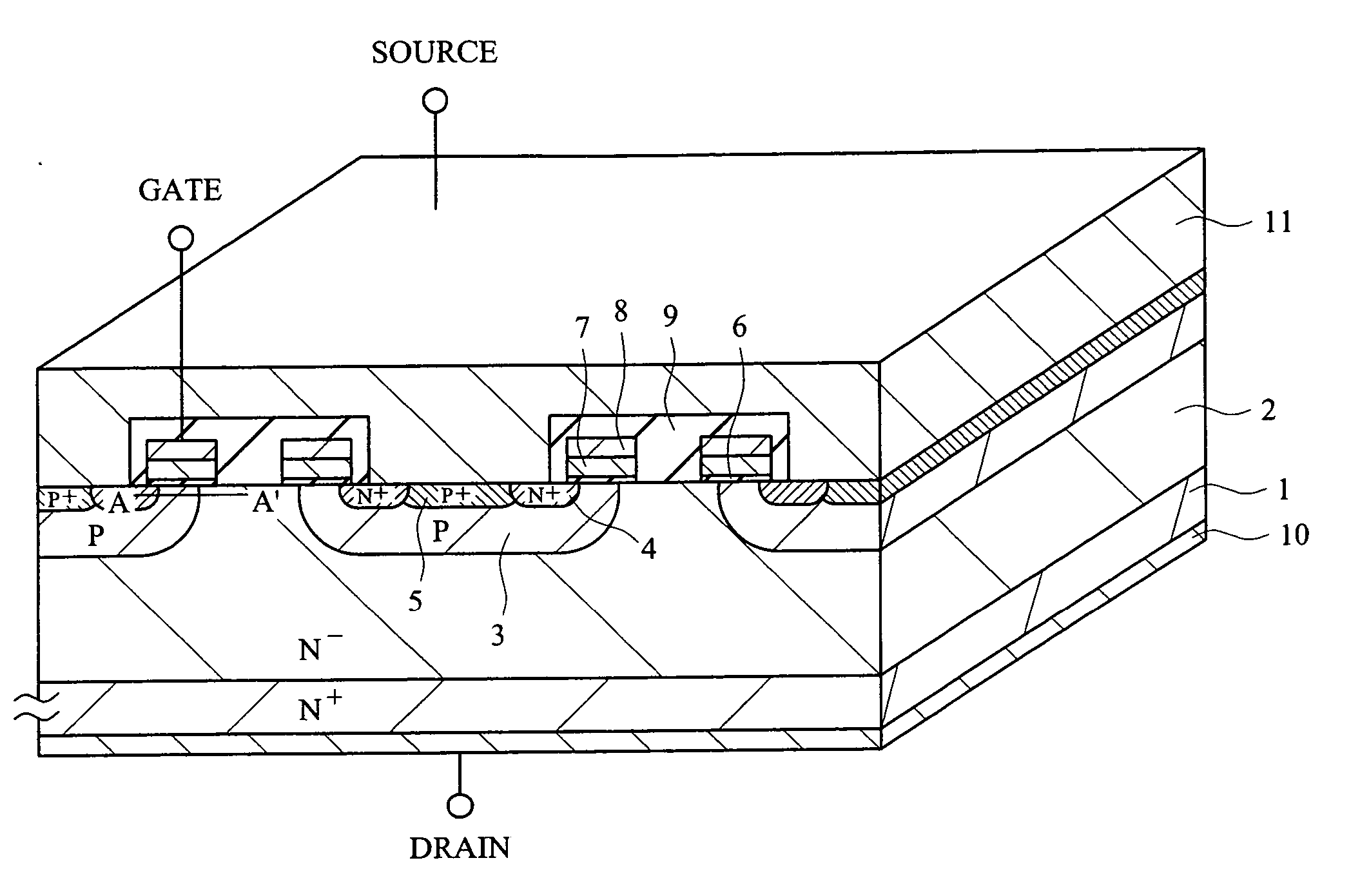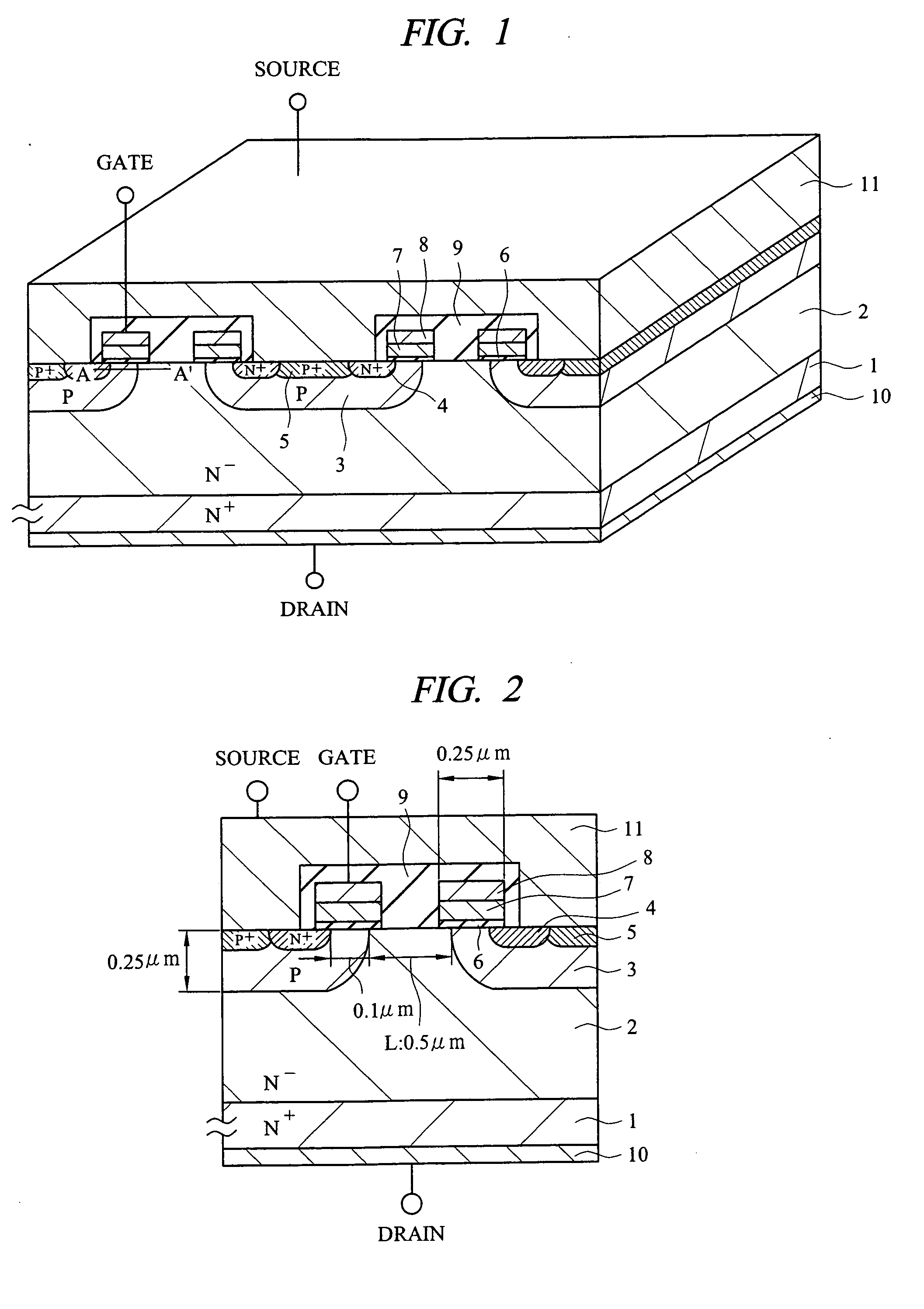DMOSFET and planar type MOSFET
a technology of mosfet and mosfet, which is applied in the direction of semiconductor devices, diodes, electrical apparatus, etc., can solve the problems of insufficient examination of shallow junctions, reduced withstand voltage, and reduced cell miniaturization, so as to reduce diffusion in a lateral direction, low on-resistance, and low feedback capacitance
- Summary
- Abstract
- Description
- Claims
- Application Information
AI Technical Summary
Benefits of technology
Problems solved by technology
Method used
Image
Examples
first embodiment
[0059] The first embodiment of the present invention will be described with reference to FIG. 1 to FIG. 8. FIG. 1 is a diagram showing a sectional structure of a planar type MOSFET according to the first embodiment of the present invention. FIG. 2 is a cross-sectional view showing the dimensions of the planar type MOSFET according to the first embodiment of the present invention.
[0060] As shown in FIG. 1, the planar type MOSFET according to the first embodiment is a planar type N channel DMOSFET (Double-Diffused MOSFET), in which an N− epitaxial layer 2 is formed on an N+ substrate 1, and P channel layers 3, N+ source regions 4, and body contact regions 5 are formed in this N− epitaxial layer 2, and P type polysilicons 7 to be gate electrodes are formed thereon via gate insulating films 6. A part of the P type polysilicon 7 opposite to the JFET region between the P channel layers 3 is removed, and a tungsten silicide film 8 is formed on the P type polysilicon 7. The upper and side ...
second embodiment
[0076] The second embodiment of the present invention will be described with reference to FIG. 13. FIG. 13 is a diagram showing a cross-sectional structure of a planar type MOSFET according to the second embodiment of the present invention. The feature of FIG. 13 lies in that the N+ source region 4 and the body contact region 5 are alternatively arranged in a direction vertical to the gate. In such an arrangement, the cell pitch can be reduced without changing the dimensions of the JFET region and the ON-resistance can be reduced.
third embodiment
[0077] The third embodiment of the present invention will be described with reference to FIG. 14. FIG. 14 is a diagram showing a cross-sectional structure of a planar type MOSFET according to the third embodiment of the present invention. The feature of FIG. 14 lies in that an oxynitride film 14 is used for the gate insulating film. In the third embodiment, the P type polysilicon 7 is used for the gate electrode and boron (B) is used as an impurity thereof. It is known that the problem of the boron penetration occurs in the case of using an oxide film which is a normal gate insulating film. More specifically, when the thermal diffusion is performed at high temperature after the deposition of the P type polysilicon, boron in the P type polysilicon penetrates through the oxide film and reaches the semiconductor substrate. When the boron penetration occurs, the threshold voltage of the MOSFET becomes unstable.
[0078] It is known that the boron penetration described above can be prevent...
PUM
 Login to View More
Login to View More Abstract
Description
Claims
Application Information
 Login to View More
Login to View More - R&D
- Intellectual Property
- Life Sciences
- Materials
- Tech Scout
- Unparalleled Data Quality
- Higher Quality Content
- 60% Fewer Hallucinations
Browse by: Latest US Patents, China's latest patents, Technical Efficacy Thesaurus, Application Domain, Technology Topic, Popular Technical Reports.
© 2025 PatSnap. All rights reserved.Legal|Privacy policy|Modern Slavery Act Transparency Statement|Sitemap|About US| Contact US: help@patsnap.com



